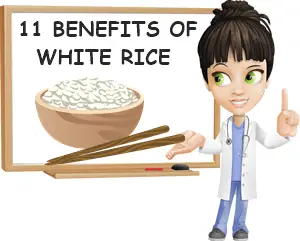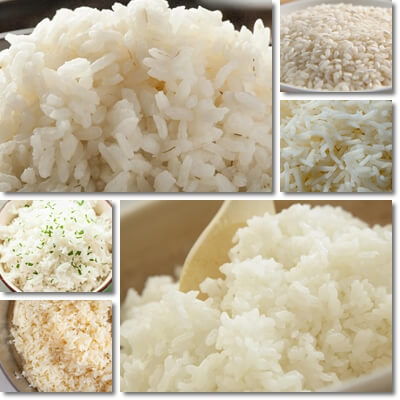White rice is primarily a source of simple carbohydrates and represents a staple food in diets around the world. The driving factors behind the popularity of white rice are its affordability and versatility. In addition to having the option to buy white rice readily pretty much anywhere for a relatively low cost, you can also pair it with all food groups from grains and cereals to meat, fish and seafood, milk and dairy, nuts, seeds, fresh and dried fruit, even sugar and other natural sweeteners such as honey.
The biggest benefits of eating white rice are that it’s a reliable source of carbohydrates that contributes to macronutrient balance in the diet, and a readily available food whose wide availability makes it accessible to pretty much everyone at a low cost. Even so, white rice has a really bad rep having been repudiated for being a refined grain, essentially a source of simple carbohydrates and nothing more, with no real contributions to a nutritious diet.

While it’s true that white rice is not even close to what could be considered a nutritious food, mainly because of the fact that its nutritional profile is headed by a high content of refined carbohydrates, without much else to show for, branding it as an undesirable food is taking things a step too far. Because even white rice can be an integral part of a well-rounded diet, and constitute a staple in a healthy, clean and balanced eating regimen, contributing towards quite a few very real benefits for health.
What are the benefits of eating white rice?
1) Helps achieve macronutrient balance
White rice can successfully account for the carbohydrate part of the diet and help achieve macronutrient balance. To be healthy and function optimally, you need to eat 3 types of macronutrients every day: protein, fat and carbohydrates. Ideally, the bulk of your carbohydrate intake should consist of complex carbohydrates such as those from whole grains: e.g. whole wheat, brown rice, black rice, purple rice, red rice, oats, maize or corn, barley, millet and others.
But it’s also ok if you get at least part of your daily carbohydrate intake from refined white rice. Despite not having the more desirable complex type of carbohydrates, refined white rice will do to in terms of balancing the macronutrient part of your diet.
Not just this, but white rice is a source of quick energy, raising blood sugar levels relatively quickly for a boost in energy levels. It’ll also help fill you up and keep you satiated between meals which is also important. In the right amounts, it can be successfully included in a diet for weight loss, or a diet for weight gain, depending on necessities.

2) It’s gluten free
One of the biggest benefits of white rice is that it’s gluten free. More exactly, white rice does not have gluten proteins present naturally in wheat and other cereal grains such as rye, barley, oats or triticale. As a result, it can substitute major sources of carbohydrates in the diet such as refined wheat, while whole grain rice varieties such as brown rice, purple rice, black rice and red rice can substitute whole wheat and other whole grains.
Gluten proteins are known to trigger a mild to severe inflammation-based immunological response in parts of the general population. Depending on the type and severity of adverse reactions exhibited in response to gluten ingestion, the skin, digestive or nervous system may be affected to various degrees.
Gluten sensitivity, gluten intolerance, gluten allergy and associated conditions respond well to exclusion of gluten which can be done by substituting sources of gluten such as wheat, rye or barley with gluten free options such as rice, corn or maize, millet, as well as amaranth, quinoa and buckwheat.
3) Helps absorb excess stomach acid in acid reflux and gastritis
Refined white rice is a staple food in an acid reflux diet, a gastritis diet, and an ulcer diet. What makes eating white rice good for acid reflux disease, gastritis and stomach ulcers is the fact that it’s a refined grain. As a refined grain, white rice is striped of complex carbohydrates and left only with simpler carbs that exert an absorbent action, ideal for soaking up and assimilating excessing stomach acid. This provides relief from symptoms and is conducive to healing.
White rice is also bland tasting, the very definition of bland food really. And it’s this exact lack of flavor that fuels further benefits for acid reflux, gastritis and stomach ulcers. More specifically, being bland tasting, white rice does not act as a trigger food for acid reflux or for gastritis, promoting a symptomless state of well being that allows the affected organs and systems to recover and resume a somewhat normal state of functioning.
This has the added benefit of limiting tissue damage such as damage to the esophagus lining, stomach lining, vocal cords etc., and allowing for healing to take place. However, if you have acid reflux disease, gastritis or a stomach ulcer, remember that it’s important to pair white rice with other bland foods that do not elicit symptoms either.
Consider light foods such as white meat (chicken breast, ground chicken breast meat, turkey breast and ground turkey breast meat, cod, gilt-head sea bream or orata fish), vegetables such as root vegetables, mushrooms, spinach and other leafy greens, and of course, refined grains such as white rice.
4) It can successfully be incorporated in weight loss diets
Did you know you can eat white rice and lose weight? Not just this, but eating white rice in a weight loss diet is actually conducive to weight loss. Eating small servings of white rice during weight loss provides a solid base of carbohydrates for quick energy and satiation, giving bulk to meals while supplying limited amounts of calories.
For example, a serving of 50 grams of plain white rice, weighed raw, provides an average of 175 kcal (kilocalories). If paired with low-calorie vegetables and a small amount of lean protein, you can achieve a diet meal that is complex macronutrient-wise, and enjoy satiation and mental satisfaction for sustainable weight loss.
5) It has nutritional value, albeit modest
White rice is not quite devoid of nutrition as it is made up to be. White rice provides good amounts of dietary manganese, a mineral with important antioxidant effects and benefits for bones and teeth. It’s also a source of selenium and phosphorus with benefits for thyroid health, fertility, metabolism and weight management.
Manganese, phosphorus and selenium in white rice are also important minerals you need for bones and teeth health. Eating white rice further contributes to daily zinc and B vitamins values, notably vitamins B6, B5 and B3. And if you choose enriched rice, then you will get additional amounts of several B vitamins.
6) It’s not always a high glycemic food
White rice is best known for its high glycemic index value. What this means is that eating refined white rice, by itself, will basically spike your blood sugar. While it’s true that white rice is typically a high glycemic food, not all varieties are high glycemic – some are moderate glycemic and a few are on the lower end of the glycemic index scale even.
Discover what is the glycemic index of rice of different varieties, cooked and uncooked.
Of course, the issue of the high glycemic index of rice, and white rice in particular, stops being an issue as you usually don’t eat rice by itself, but with vegetables rich in dietary fiber, meat, eggs, cheese, fish or seafood which are sources of protein and fat to help temper the effects of the rice on blood sugar.
7) You can make a rice based meal lower glycemic
Even if white rice is a high glycemic food, you can reduce its effects on blood sugar by eating smaller serving sizes and pairing the rice with the right foods. Eggs, cheese, meat, fish and seafood, but also vegetables, nuts, seeds are all great foods to pair with white rice as their content of protein, fat, dietary fiber and complex carbs tempers the rise in blood sugar, achieving an overall lower glycemic effect of the meal.
8) Eating white rice helps stop diarrhea
White rice is a refined grain and has an absorbent, binding action on stools that are too lose. When you have diarrhea, one of the best things you can eat is plain boiled white rice to help stop the diarrhea and the loss of fluids associated with it. You can also eat the rice with a baked or boiled fruit such as an apple, quince or pear, with a fresh banana or apple, or drink the rice water.
Find out more about what to eat when you have diarrhea.
9) Eating white rice supports intellectual effort and cognitive functions
One of the more surprising benefits of eating white rice is it supports intellectual effort and cognitive functions such as thinking, learning and attention. The way it does this is by feeding the brain simple carbs.
The brain’s primary choice of food are carbs which help support cognition as a whole, and intellectual effort.
Eating carbs, including simple carbs such as those from white rice, but also fruit, provides quick energy and nourishment for the brain, actively helping support brain activity.
There are times when the brain requires quick food to perform its various functions at which point simple carbs are the solution.
10) White rice is satiating and filling
White rice is a solid source of food, representing the carbohydrate part of a diet. Despite not being exceptional in any way when it comes to its nutrition, white rice remains a satiating and filling food accessible at a low cost. It doesn’t just curb hunger straight away, while at the same time providing quick energy for the body to use for both cognitive functions and physical effort, but also keeps you satiated for up to several hours.
11) Has a bland taste that makes it good for nausea
One of the better known benefits of white rice is that it’s good to eat for nausea and vomiting. Because it’s bland and utterly flavorless, it doesn’t trigger nausea and is one of the few things a lot of people can keep down when dealing with bouts of vomiting. And because it’s a source of simple carbs, it also raises blood sugar levels and provides a quick source of energy for an overly exerted system.
White rice further makes a good base for sweet and savory dishes which means you can pair it with a crisp apple grated on top, or a banana, or anything you feel you can keep down that will also stimulate your appetite to get some food in you.
